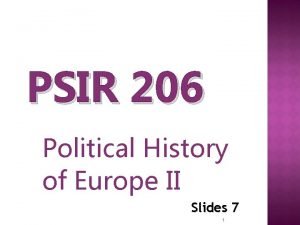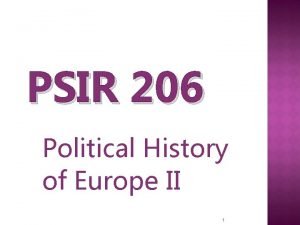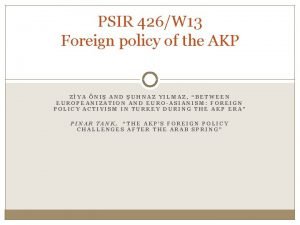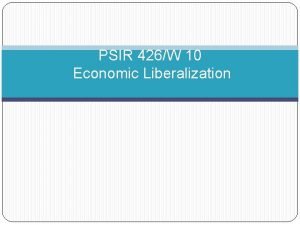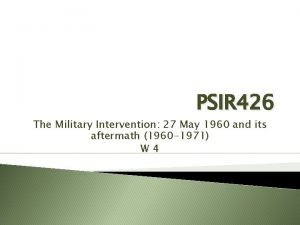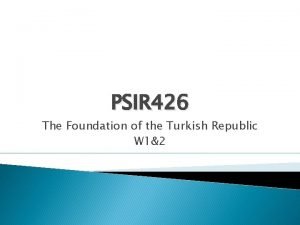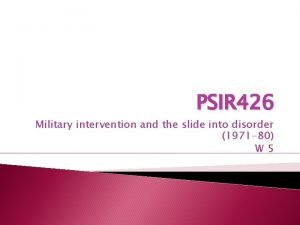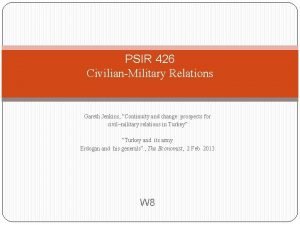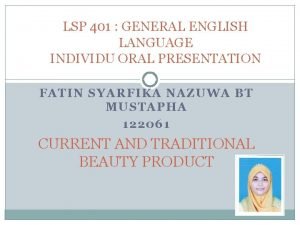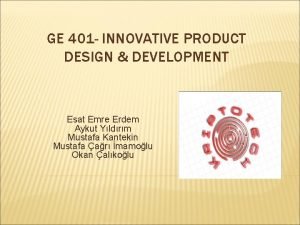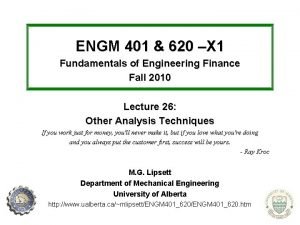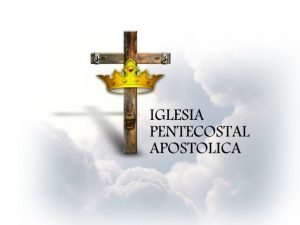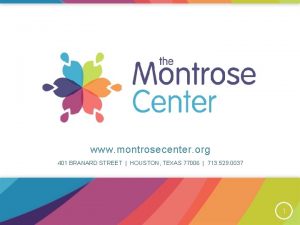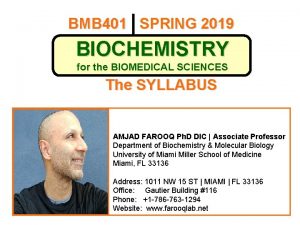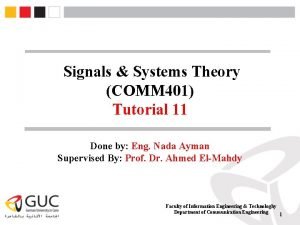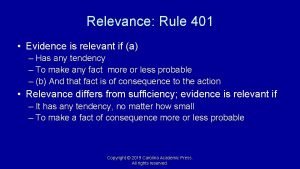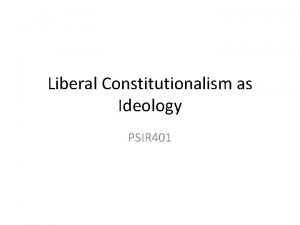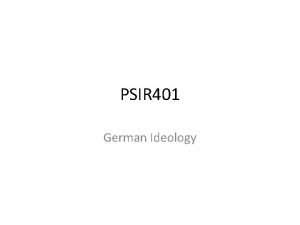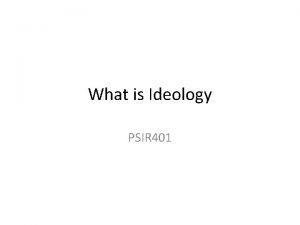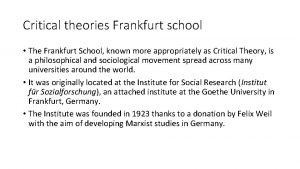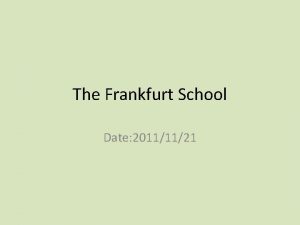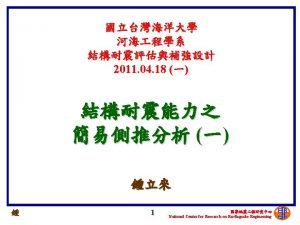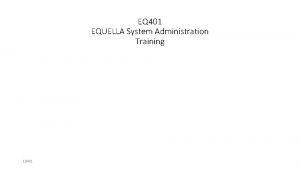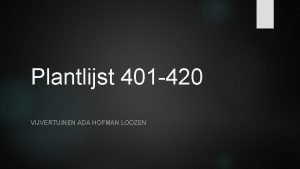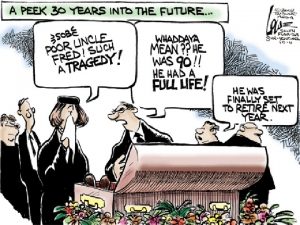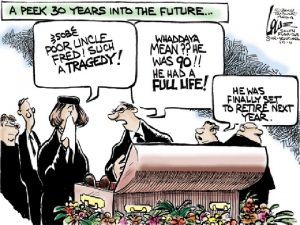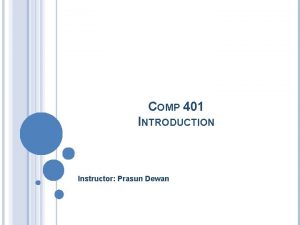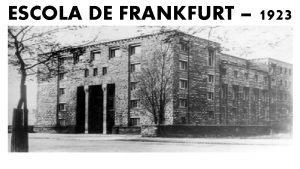Frankfurt School PSIR 401 The Frankfurt School also



















- Slides: 19

Frankfurt School PSIR 401

• The Frankfurt School, also known as the Institute of Social Research (Institut für Sozialforschung). • A social and political philosophical movement of thought located in Frankfurt am Main, Germany. It is the original source of what is known as Critical Theory. • The Institute eventually generated a specific school of thought after 1933 when the Nazis forced it to close and move to the United States, where it found hospitality at Columbia University, New York.

What is critical? • Some of its core issues involve: – the critique of modernities and – of capitalist society, – the definition of social emancipation – and the perceived pathologies of society.

• Critical theory provides a specific interpretation of Marxist philosophy and reinterprets some of its central economic and political notions: – such as commodification, reification, fetishization and critique of mass culture.

• Some of the most prominent figures of the first generation of Critical Theorists are Max Horkheimer (1895 -1973), Theodor Adorno (1903 -1969), Herbert Marcuse (1898 -1979), Walter Benjamin (1892 -1940), Friedrich Pollock (1894 -1970), Leo Lowenthal (19001993), Eric Fromm (1900 -1980).

• the second generation has been led by Jürgen Habermas who has greatly contributed to fostering the dialogue between the so called “continental” and “analytical” tradition

Generation gap • The “first generation” of critical theorists was largely occupied with the functional and conceptual requalification of Hegel’s dialectics. • After Habermas, preference has been assigned to the understanding of the conditions of action coordination through the underpinning of the conditions of validity for speech-acts. • The third generation, then, following the works of Honneth, turned back to Hegel’s philosophy and in particular to Hegel’s notion of “recognition” as a cognitive and prelinguistic sphere grounding intersubjectivity.

• From the beginning, psychoanalysis in the Frankfurt School was conceived in terms of a reinterpretation of Freud and Marx. • Horkheimer’s leadership provided a very distinct methodological direction and philosophical grounding to the Institute’s research interests. Against the so-called Lebensphilosophie (philosophy of life), he criticized the fetishism of subjectivity and the lack of consideration for the materialist conditions of life.

• Furthermore, arguing against Cartesian and Kantian philosophy, he attempted to rejoin all dichotomies - like those between consciousness and being, theory and practice, fact and value - through the use of dialectical mediation.

• In 1933, due to the Nazi takeover, the Institute temporarily transferred first to Geneva and then in 1935 to New York and Columbia University. Two years later Horkheimer published the ideological manifesto of the School in his “Traditional and Critical Theory” ([1937] 1976), where some of the already anticipated topics were addressed, such as the practical and critical turn of theory. In 1938 Adorno joined the Institute after spending time at Merton College, Oxford as an “advanced student. ” He was invited by Horkheimer to join the Princeton Radio Research Project together with Lazarsfeld.

• one of the School’s major topics of study was Nazism. • The other, guided by Horkheimer, focused on psychological irrationalism as a source of obedience and domination (see Jay 1996, p. 166).

• The sixties – which saw famous student protests across Europe – also saw the publication of Adorno’s fundamental work, Negative Dialectics (1966). • Marcuse had just published One-Dimensional Man (1964), . • While Marcuse quite ostensibly sponsored the student upheavals, Adorno maintained a much more moderate and critical profile.

• In 1956, Habermas joined the Institute as Adorno’s assistant, and was soon involved in an empirical and cooperative study under the title of Students and Politics. • Discussion of the notion of “emancipation” has been at the center of the Frankfurt School’s political contention and of its philosophical debates. • In his two-volume work Theory of Communicative Action (1984 b [1981]), Habermas provided a model of social complexities and action coordination based upon the original interpretation of classical social theorists as well as contemporary philosophy of language such as Searle’s Speech Acts theory. • Habermas describes discourse theory as characterized by three types of validityclaims raised by communicative acts: it is only when the conditions of truth, rightness and sincerity are raised by speech-acts that social coordination is obtained.

Critical theory • Traditional theory, whether deductive or analytical, has always focused on coherency and on the strict distinction between theory and praxis. • Along Cartesian lines, knowledge was treated as being grounded upon self -evident propositions, or at least upon propositions derivable from selfevident truths. • Traditional theory proceeded to explain facts through the application of universal laws, so that by the subsumption of a particular into the universal, law was either confirmed or disconfirmed. • If one were to defend the view according to which scientific truths, in order to be considered so, should pass the test of empirical confirmation, then he would commit himself to the idea of an objective world. Knowledge would be simply a mirror of reality. This point is firmly refused by Critical Theory.

• the logical form of propositions consists in “showing” a possible fact and in “saying” whether this is true or false. • For example, the proposition “it rains today”, shows both the possibility of the fact that “it rains today”, and says that it is actually the case that “it rains today. ” • In order to check whether something is or is not the case, I have to verify empirically whether it occurs or not. This implies that the condition of truth and falsehood presupposes an objective structure of the world.

• Horkheimer and his followers rejected the notion of objectivity in knowledge by pointing, among other things, to the fact that the object of knowledge is itself embedded into an historical and social process. • Critical Theory thus wants to abandon naïve conceptions of knowledge-impartiality. Since intellectuals themselves are not disembodied entities reflecting from outside, knowledge can be obtained only from within a society of interdependent individuals.

• Critical Theory has been strongly influenced by Hegel’s notion of dialectics, the latter aimed at reconciling socio-historical oppositions, as well as by Marx’s theory of economy and society and the limits of Hegel’s “bourgeois philosophy”. • Critical theorists, in their turn, rejected both the metaphysical apparatus of Hegel and the eschatological aspects connected to Marx’s theory

• Ideology, which according to Marx, was totally explicable through the underlying system of production, had, for critical theorists, to be analyzed in its own respect and as a non-economically reducible form of expression of human rationality. • Such a revision of Marxian categories became extremely crucial, then, in the reinterpretation of the notion of dialectic for the analysis of capitalism. • In the light of this, dialectic, as a method of social criticism, was interpreted as following from the contradictory nature of capitalism as a system of exploitation. Indeed, it was on the basis of such inherent contradictions that capitalism was seen to open up to a collective form of ownership of the means of production, that is, socialism.

• the normativity of social philosophy as something distinct from classical descriptive sociology • ideological criticism has the function of unmasking wrong rationalizations of present or past injustices
